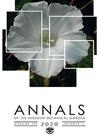A Monograph of Operculina (Convolvulaceae)
IF 1.1
3区 生物学
Q3 PLANT SCIENCES
引用次数: 6
Abstract
A comprehensive systematic monograph is presented for the genus Operculina Silva Manso (Convolvulaceae). Formerly included in tribe Merremieae D. F. Austin, now incertae sedis, recent systematic studies have clarified the phylogenetic relationships for Operculina and unequivocally demonstrated that it is monophyletic as currently circumscribed and that the unique operculate capsule is a synapomorphy for the genus. Other morphological characters useful for recognizing the genus are: large sepals forming a “pear-shaped” calyx that is broad at the base and tapers upward; calyx that is accrescent and persistent, often cupping the mature fruit; strongly spirally coiled anthers after dehiscence; and axial parts of the plant body (stems, petioles, peduncles, pedicels) that are often prominently winged. The current monograph accepts 13 species, including one variety and one purported hybrid; these taxa are distributed throughout the tropics globally. The hybrid is proposed to accommodate the extraordinary phenotypic variability and intermediacy among South Pacific populations of Operculina. The monograph provides detailed descriptions for all taxa, as well as an identification key, distribution maps, and summaries of ecology, phenology, vernacular names, and uses, with comments on synonymy, typification, variability, biology, and conservation, where appropriate. All names published or combined in Operculina (about 60 epithets) are accounted for as accepted names, synonyms, misapplied names, or uncertain names, or are excluded from the genus. New reductions to synonymy are proposed as follows: O. brownii Ooststr. becomes a synonym of O. codonantha (Benth.) Hallier f.; O. tansaensis Santapau & V. Patel becomes a synonym of O. ventricosa (Bertero) Peter. Lectotypes, neotypes, and epitypes are designated where necessary to stabilize names in current use. An index to numbered collections examined is provided to aid in specimen identification and herbarium curation.旋花科植物Operculina的一个专著
本文对旋花科植物Operculina Silva Manso属进行了系统的研究。以前被包括在Merremeae D.F.Austin部落,现在是sedis的incertae,最近的系统研究已经阐明了Operculina的系统发育关系,并明确证明了它是目前限定的单系,独特的操纵子囊是该属的一种突触形态。其他有助于识别该属的形态特征有:大的萼片形成“梨形”的花萼,基部宽,向上渐缩;增大和宿存的花萼,通常杯状的成熟果实;强烈螺旋状卷曲的花药在开裂后;和植物体的轴状部分(茎、叶柄、花序梗、椎弓根),通常显著具翅。目前的专著接受了13个物种,包括一个变种和一个所谓的杂交种;这些分类群分布在全球热带地区。该杂交种是为了适应南太平洋Operculina种群之间非凡的表型变异性和中间性而提出的。该专著提供了所有分类群的详细描述,以及识别钥匙、分布图、生态学、酚学、白话名称和用途的摘要,并在适当的情况下对同义词、典型化、变异性、生物学和保护进行了评论。在Operculina中发表或组合的所有名称(约60个修饰语)都被视为可接受的名称、同义词、误用的名称或不确定的名称,或被排除在属外。对同义词提出了新的简化如下:O.browni-Ooststr。成为O.codonantha(Benth.)Hallier f的同义词。;O.tansaensis Santapau和V.Patel成为O.ventricosa(Bertero)Peter的同义词。Lectotypes、neotypes和表型在必要时指定,以稳定当前使用的名称。提供了编号藏品的索引,以帮助标本鉴定和植物标本馆管理。
本文章由计算机程序翻译,如有差异,请以英文原文为准。
求助全文
约1分钟内获得全文
求助全文
来源期刊
CiteScore
3.60
自引率
0.00%
发文量
15
期刊介绍:
The Annals of the Missouri Botanical Garden is a quarterly international journal primarily devoted to systematic botany and evolutionary biology. We encourage submissions of original papers dealing with significant advances in the taxonomy, phylogeny, biogeography, paleobiology, and evolution of plants, and in conservation genetics and biology, restoration ecology, and ethnobiology, using morphological and/or molecular characters, field observations, and/or database information. We also welcome reviews and papers on conceptual issues and new methodologies in systematics. Important floristic works will also be considered. Symposium proceedings discussing a broader range of topical biological subjects are also published, typically once a year. All manuscripts are peer-reviewed by qualified and independent reviewers.

 求助内容:
求助内容: 应助结果提醒方式:
应助结果提醒方式:


